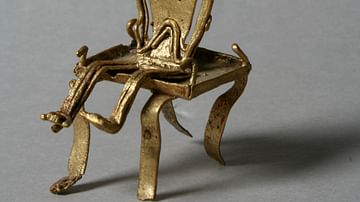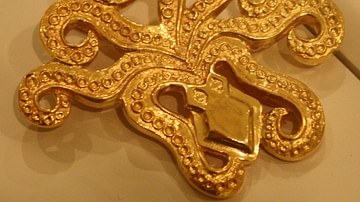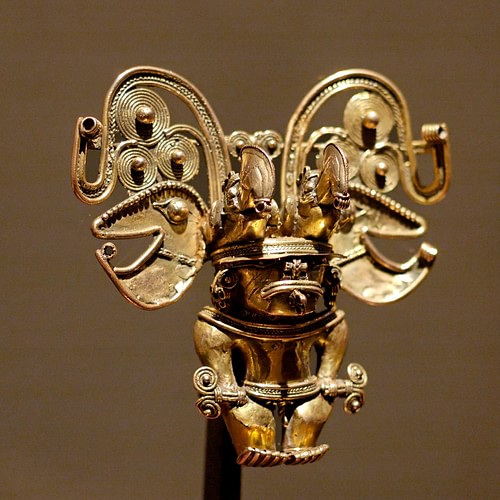
The Tairona civilization - one of the Chibcha family tribes - flourished in northern Colombia between 200 CE and 1600 CE. Like the Muisca of Cundinamarca, the Tairona were known for their expertise in crafting and metallurgy, especially goldsmithing. Primarily occupying the Sierra Nevada de Santa Marta region in present-day Magdalena, they left behind them a bountiful of archaeological evidence of their lifestyle, which was surprisingly modern as viewed from the perspective of their relative isolation to more developed civilizations.
HISTORICAL OVERVIEW
The Tairona were as skilled in agriculture as they were in metallurgy. Archaeological findings from as early as 200 CE show that they had the knowledge and expertise of terrace farming, canal building and construction of stone foundations. But that is not what they are renowned for; they are remembered for their exceptional war skills, which made them one of the most difficult tribes to be colonized by the Spanish conquistadores, who had successfully been able to overthrow the Inca, the Aztec, and the Maya empire without much effort. The Tairona ended up fighting with the conquistadores for more than 75 years.
Not surprisingly, many Spaniards became admirers and wrote records about this mysterious, all-powerful tribe that could resist western influence. Many chroniclers recorded the Tairona way of life, their trading systems, their religious beliefs, and their apparent lack of interest in the monetary value of precious metals. So it is not very surprising that the Tairona are believed to be related to the Muisca tribe, as they both shared the same system of power division and a belief in the spiritual significance of gold.
IMPORTANT SITES
The Tairona had to abandon their settlements around mid-17th century CE, and the forests swallowed most of their traces. Still, some remain, a reminder of their remarkable culture.
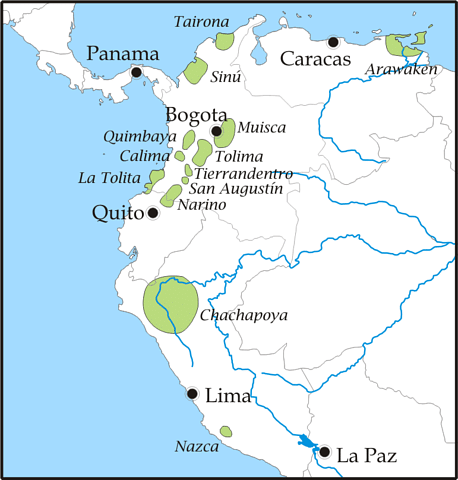
One of their most famous settlements was Ciudad Perdida (The Lost City). Locally known as Teyuna, it was founded around 800 CE, 600 years before Machu Picchu. It is one of the most important pre-Columbian archaeological sites in South America. Accessible by a tiring long trek through thick foliage and some 1,200-odd stone steps, it is believed to have housed anywhere from 2,000 to 8,000 people. Until now, only a part of the once-magnificent city has been properly excavated. The findings have been extraordinary; about 250 mud and stone terraces that served as platforms for houses, spread across 300,000 square meters of densely vegetated land. More recent excavations have also unearthed a number of intriguing objects; ornaments, gold offerings, pottery, and even musical instruments.
Another site, Pueblito, is located near the Carribean coast. According to research, it contains at least 254 terraces and housed a population of about 3,000 people. In the past, there used to be numerous villages and hamlets strewn throughout the valley, forming a large network that would increase trade and other businesses. In fact, the Tairona were even involved in salt production, as found in Chengue, a small fishing village.
SOCIETY
The Tairona had a ruling system based on religion. Their rulers were a part of Shaman elite that claimed to be able to control the forces of nature, the cosmos and all human thoughts and actions. One of the chief beliefs of the Tairona people was in the process of transformation. The process is a typical shamanistic power exchange. By cleansing their mind and body, going through long periods of fasting, and exhaustive ritual dances, they believed the shamans' souls could transcend the mortal human condition and acquire knowledge from unknown regions of the cosmos which would be inaccessible to anyone else. Hence the shamans were considered the heads of the tribe and were treated with a great deal of respect, being responsible for gathering armies, controlling agriculture, looking out for the wellbeing of the Tairona, and even supervising the barter trade network. It was the belief of the Tairona that the shamans could escape their body and gain the knowledge of other creatures, which inspired their metallurgy. Most of the ornaments found in their settlements are believed to be of people turning into fierce animals such as the famous 'Bat Man' figurine that depicts a shaman slowly turning into a bat.
RELIGION & ART
Like most tribes thriving in that period, the Tairona's religious beliefs influenced a lot of their artwork and metallurgy. Like the 'Bat Man,' most of their pendants and breastplates boasted of men apparently turning into fearsome creatures, especially birds of prey, crocodiles, and snakes. These ornaments not only represented the status of the person wearing them but also were symbols of the powers he was supposed to be possessing.
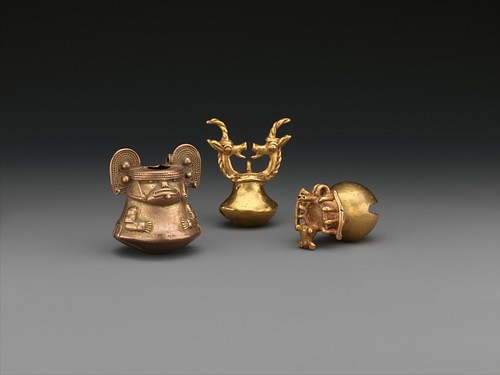
Transformation was a concept that all tribes of the Chibcha family believed in at that time, and they did their best to implement it. For example, since bats were recognized as one of the most powerful animals then, the Tairona did their best to make themselves look like them. As a result, the costumes that were worn for symbolizing this transformation have been found in the tombs of leading dignitaries of the Tairona period. Researchers at the Banco de la Republica, Colombia, say, "The ornamentation on their metal visors was an allusion to the membranes inside the animal's ear; the cylindrical nose rings raised the nose to make it look like the nostril of certain bat species, and the sub-labial ornaments imitated the fleshiness of the animal's lower lip."
Unlike what most people tend to believe, ancient Colombia was not only a hub for excellent goldwork but also for ceramics. The earliest ceramic objects excavated from the area occupied by the Tairona were dated around 2500 BCE, even though they are believed to have flourished only after 200 CE. Another link to the Muisca seems to be the similarity in goldwork. Both of these Chibcha-speaking tribes had the same variety of offerings for their deities and even had almost the same kind of tunjos. Tunjos are figurines made from tumbaga, which is a mixture of gold, copper, and silver. They generally depict the tribespeople going about their daily life. Another interesting aspect of the modernity of the Tairona is that scholars believe the tribespeople had freedom of divorces. Also, their religious practices were very similar to their present-day counterparts, the Kogui, and went on for days, primarily involving deliberation, coca chewing, and deep meditation.
